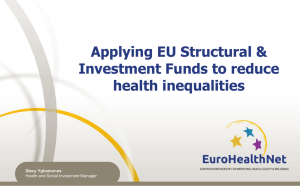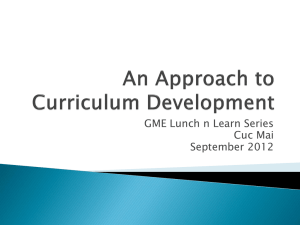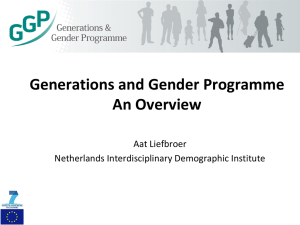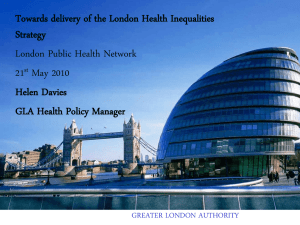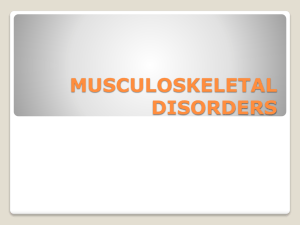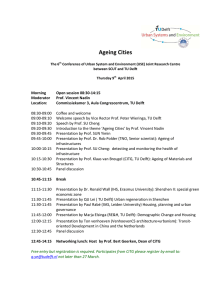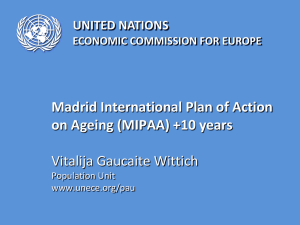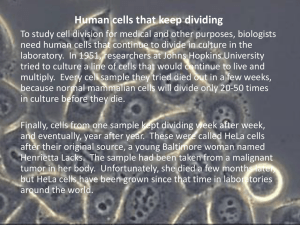Dr Holly Syddall - University of Southampton
advertisement
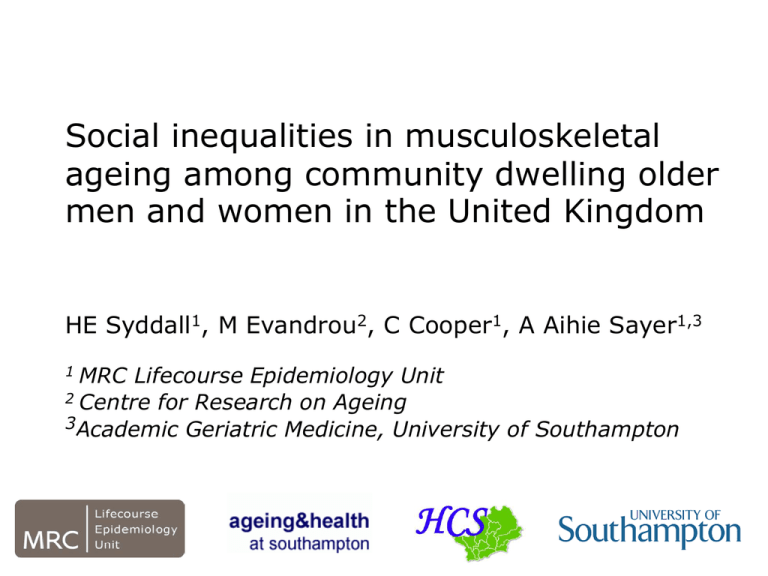
Social inequalities in musculoskeletal ageing among community dwelling older men and women in the United Kingdom HE Syddall1, M Evandrou2, C Cooper1, A Aihie Sayer1,3 MRC Lifecourse Epidemiology Unit 2 Centre for Research on Ageing 3Academic Geriatric Medicine, University of Southampton of Southampton 1 Background • Musculoskeletal disorders are a major problem in older people and place a substantial burden on UK health and social care services • The UK has an ageing population • Improved understanding of the patterns and determinants of musculoskeletal ageing is needed for planning of health and social care services, and development of interventions to promote healthy ageing at the individual level. Background • Social inequalities in health have been recognised for centuries • Even in generally wealthy Western countries, health inequalities exist across relative levels of deprivation (Reproduced from “Fair society, healthy lives”, Marmot Review final report, 2010) • Little is known about social inequalities in musculoskeletal ageing Objective To explore social inequalities in musculoskeletal ageing using data from community dwelling ‘young-old’ men and women, aged 59-73 years, who participated in the Hertfordshire Cohort Study (HCS) Methods: the Hertfordshire Cohort Study A study of lifecourse influences on human health, ageing and disease 2997 men and women born 1931 – 1939 Methods paper: Syddall et al, IJE 2005 Methods: data availability Socioeconomic position and material deprivation • Age left full time education • Social class in adulthood • Housing tenure • Car availability Methods: data availability Socioeconomic position and material deprivation • Age left full time education • Social class in adulthood • Housing tenure • Car availability Musculoskeletal ageing • Grip strength (maximum, Jamar) • Self-assessed physical function (SF-36) • History of falls in the past year • Fried frailty • Fracture history (any/minor trauma) • DXA scan (total femoral BMD and bone loss rate) • Novel pQCT scanning of radius and tibia (strength strain indices) Results: socioeconomic position and material deprivation % Men Women (N=1684) (N=1541) Left full time education ≤14 years of age 19.4 17.9 Manual social class (IIIM,IV,V) 59.3 58.4 Housing tenure Owned/mortgaged Rented/other 80.7 19.3 76.9 23.1 Household car availability None 1 2 3+ 6.4 53.5 32.9 7.3 17.1 58.0 21.4 2.9 Results: musculoskeletal ageing Mean (SD) or % Grip strength (kg) Fallen in the past year Fried frailty Any fracture since 45 years of age Minor trauma fracture since 45 years of age DXA total femoral BMD (g/cm2) Men Women (N=1684) (N=1541) 44.0 (7.5) 26.5 (5.8) 14.9 22.6 4.1 8.5 14.0 21.6 7.7 18.4 1.04 (0.13) 0.90 (0.13) Sample sizes men/women: grip 1572/1415; falls 941/1398; frailty 320/318; DXA BMD 498/468 Results: social inequalities in grip strength Average grip strength 47 46 29 Men Women P<0.001 P<0.001 45 27 44 43 25 42 41 23 40 39 21 None 1 2 3+ None 1 2 3+ Number of cars available for household use Average grip strength 47 46 29 Men Women P<0.0001 P<0.0001 27 45 44 25 43 42 23 41 40 21 39 Owned/mortgaged Rented/other Owned/mortgaged Home ownership Rented/other Results: social inequalities in grip strength MEN 46kg Mean grip strength kg (95%CI) 50 WOMEN 34 32 48 27kg 40kg 30 46 24kg 28 44 42 26 40 24 38 22 No No cars cars 1 1 Owned/mortgaged 2 2 3 or 3+ more Rented/other 1 2 No cars 3 14 Owned/mortgaged 5 26 7 3+8 Rented/other Fully adjusted p-values: p=0.02 for housing tenure and p=0.03 for car availability in men; p=0.004 for housing tenure and p=0.002 for cars in women Results: social inequalities in physical functioning 52% Prevalence (%) of poor PF (95%CI) MEN WOMEN 90 70 80 60 42% 70 50 60 14% 40 15% 50 40 30 30 20 20 10 10 0 0 No No cars cars 1 1 Owned/mortgaged 2 2 3 or 3+ more Rented/other 1 2 No cars 3 1 4 Owned/mortgaged 5 2 6 7 3+ 8 Rented/other Poor PF defined as a score in the lowest fifth of the sex-specific distribution (<=75 for men; <=60 for women). Fully adjusted p-values: p=0.003 for housing tenure and p<0.001 for car availability in men; p=0.12 for housing tenure and p=0.05 for cars in women Results: social inequalities in Fried frailty 18 18 16 14 % Frail 16 p=0.01 men p=0.16 women 14 12 12 10 10 8 8 6 6 4 4 2 2 0 0 None 1 2 3+ Number of cars available for household use p=0.05 men p=0.02 women Owned/mortgaged Rented/other Home ownership Men Women Discussion • Recap: we have identified a specific pattern of evidence for social inequalities in muscle, but not bone, based aspects of musculoskeletal ageing Discussion • Recap: we have identified a specific pattern of evidence for social inequalities in muscle, but not bone, based aspects of musculoskeletal ageing •Why? Discussion • Recap: we have identified a specific pattern of evidence for social inequalities in muscle, but not bone, based aspects of musculoskeletal ageing • Why? different social patterning and different associations of muscle and bone with height and fat mass diet physical activity Discussion • Recap: we have identified a specific pattern of evidence for social inequalities in muscle, but not bone, based aspects of musculoskeletal ageing • Why? different social patterning and different associations of muscle and bone with height and fat mass diet physical activity • Responsiveness of ageing muscle and bone to physical activity • Further research is needed to identify the impact of different types of physical activity (resistance/aerobic; customary/occupational) on social inequalities in musculoskeletal ageing Conclusions • Any clinical interventions designed to reduce the loss of muscle mass and function with age should be targeted proportionately across the social gradient; strategies to reduce fracture and osteoporosis should continue with a universal population focus • There exists a subgroup of older men and women in the UK who face increased levels of material deprivation in combination with greater loss of muscle strength and physical function • It is these men and women who urgently need the government to commit to reform of the funding system for adult care and support Acknowledgements • • • Study participants Hertfordshire GPs Hertfordshire Cohort Study Team • Professors Avan Aihie Sayer, Maria Evandrou and Cyrus Cooper • Funding: – MRC – University of Southampton – BHF, ARC, NOS, Wellcome Trust
